Real-Time Optical Fiber Salinity Interrogator Based on Time-Domain Demodulation and TPMF Incorporated Sagnac Interferometer
Abstract
:1. Introduction
2. Working Principle and Experimental Setup
3. Experimental Results
4. Discussion
5. Conclusions
Author Contributions
Funding
Institutional Review Board Statement
Informed Consent Statement
Data Availability Statement
Acknowledgments
Conflicts of Interest
References
- James, S.W.; Tatam, R.P. Optical fibre long-period grating sensors: Characteristics and application. Meas. Sci. Technol. 2003, 14, R49–R61. [Google Scholar] [CrossRef]
- Sahota, J.K.; Gupta, N.; Dhawan, D. Fiber Bragg grating sensors for monitoring of physical parameters: A comprehensive review. Opt. Eng. 2020, 59, 060901. [Google Scholar] [CrossRef]
- Yibin, L.; Lin, W.; Vai, M.I.; Shum, P.P.; Shao, L.-Y.; He, W.; Liu, S.; Zhao, F.; Wang, W.; Yuhui, L. Fiber Optic Electric Field Intensity Sensor Based on Liquid Crystal-Filled Photonic Crystal Fiber Incorporated Ring Laser. IEEE Photonics J. 2022, 14, 1–5. [Google Scholar] [CrossRef]
- Cui, X.; Hu, X.; Cui, C.; Zhang, Y.; Wang, Q. Research on the fiber intensity modulation model of superconducting magnetic levitation rotor. Rev. Sci. Instrum. 2024, 95. [Google Scholar] [CrossRef] [PubMed]
- Kersey, A.D.; Davis, M.A.; Patrick, H.J.; LeBlanc, M.; Koo, K.P.; Askins, C.G.; Putnam, M.A.; Friebele, E.J. Fiber grating sensors. J. Light. Technol. 1997, 15, 1442–1463. [Google Scholar] [CrossRef]
- Mihailov, S.J. Fiber Bragg Grating Sensors for Harsh Environments. Sensors 2012, 12, 1898–1918. [Google Scholar] [CrossRef] [PubMed]
- Sharma, A.K.; Jha, R.; Gupta, B.D. Fiber-Optic Sensors Based on Surface Plasmon Resonance: A Comprehensive Review. IEEE Sens. J. 2007, 7, 1118–1129. [Google Scholar] [CrossRef]
- Liang, W.; Huang, Y.; Xu, Y.; Lee, R.K.; Yariv, A. Highly sensitive fiber Bragg grating refractive index sensors. Appl. Phys. Lett. 2005, 86, 151122. [Google Scholar] [CrossRef]
- Jiang, L.; Yang, J.; Wang, S.; Li, B.; Wang, M. Fiber Mach–Zehnder interferometer based on microcavities for high-temperature sensing with high sensitivity. Opt. Lett. 2011, 36, 3753–3755. [Google Scholar] [CrossRef] [PubMed]
- Tian, T.; Han, J.; Liang, K.; Li, S.; Ma, Y.; Geng, T.; Yuan, L. A temperature sensor based on multi-beam capture and interference. Sens. Actuators A Phys. 2024, 375. [Google Scholar] [CrossRef]
- Tian, Z.; Yam, S.S.H.; Loock, H.-P. Refractive index sensor based on an abrupt taper Michelson interferometer in a single-mode fiber. Opt. Lett. 2008, 33, 1105–1107. [Google Scholar] [CrossRef]
- Ni, C.; Zhao, M.; Wang, X.; Tan, Z. Research on the application of interferometric optical fiber sensors in high-pressure gas pipelines. Opt. Fiber Technol. 2024, 87. [Google Scholar] [CrossRef]
- Huang, H.; Liu, J.; Wu, H.; Liang, L.; Wang, C.; Zhou, A. Highly Sensitive Fiber Temperature Sensor Based on Photopolymer Probe and Vernier-Like Effect. IEEE Sens. J. 2023, 23, 30286–30292. [Google Scholar] [CrossRef]
- Lee, C.E.; Taylor, H.F. Fiber-optic Fabry-Perot temperature sensor using a low-coherence light source. J. Light. Technol. 1991, 9, 129–134. [Google Scholar] [CrossRef]
- Zhao, Y.; Li, C.; Zuo, Y.; Xia, L. Half-Wave Voltage Measurement Method Based on SI and Time-Domain Pulse Intensity Demodulation. IEEE Photonics Technol. Lett. 2024, 36, 865–868. [Google Scholar] [CrossRef]
- Li, M.; Lin, Z.; Shi, W.; Wang, R.; Qiao, X. On-Chip Demodulation Approach Based on Microring Resonator for Fiber-Optic Vernier Effect Sensing. IEEE Sens. J. 2024, 24, 17812–17816. [Google Scholar] [CrossRef]
- Zhao, F.; Lin, W.; Hu, J.; Liu, S.; Yu, F.; Chen, X.; Wang, G.; Shum, P.P.; Shao, L. Salinity and Temperature Dual-Parameter Sensor Based on Fiber Ring Laser with Tapered Side-Hole Fiber Embedded in Sagnac Interferometer. Sensors 2022, 22, 8533. [Google Scholar] [CrossRef] [PubMed]
- Liu, Y.; Lin, W.; Zhao, F.; Zhang, X.; Shao, L.-Y. Dual-Parameter Fiber Sensors for Salinity and Temperature Measurement Based on a Tapered PMF Incorporated With an FBG in Sagnac Loop. IEEE Photonics J. 2024, 16, 1–7. [Google Scholar] [CrossRef]
- Kumar, N.; Ramachandran, K. Dynamic spectral maneuvering by fiber Sagnac loop filter. Opt. Laser Technol. 2014, 63, 144–147. [Google Scholar] [CrossRef]
- Mortimore, D.B. Fiber loop reflectors. J. Light. Technol. 1988, 6, 1217–1224. [Google Scholar] [CrossRef]
- Morishita, K.; Shimamoto, K. Wavelength-selective fiber loop mirrors and their wavelength tunability by twisting. J. Light. Technol. 1995, 13, 2276–2281. [Google Scholar] [CrossRef]
- Aslam Mollah, M.; Yousufali, M.; Rifat Bin Asif Faysal, M.; Rabiul Hasan, M.; Hossain, M.B.; Amiri, I.S. Highly sensitive photonic crystal fiber salinity sensor based on Sagnac interferometer. Results Phys. 2020, 16, 103022. [Google Scholar] [CrossRef]
- Jin, R.; Shi, F.; Li, C.; Ma, B.; He, C.; Du, Y.; Wang, C.; Jia, B. All-Fiber Remote Acoustic Source Positioning System Utilizing Multi-Wavelength EDFRL. IEEE Photonics Technol. Lett. 2024, 36, 849–852. [Google Scholar] [CrossRef]
- Wang, Y.; Guo, M.; Liu, X.; Bai, Q.; Wang, D.; Zhang, M.; Jin, B. Distributed acoustic sensor based on improved minimum control recursive average algorithm. Opt. Fiber Technol. 2019, 50, 125–131. [Google Scholar] [CrossRef]
- Aoun, C.G.; Mansour, N.; Dornaika, F.; Lagadec, L. Environmental Constraints for Intelligent Internet of Deep-Sea/Underwater Things Relying on Enterprise Architecture Approach. Sensors 2024, 24, 2433. [Google Scholar] [CrossRef]
- Wang, S.; Wang, T.; Li, B.; Du, S.; Li, D.; Chen, B. Multi-parameter sensor based on dumbbell stepped fiber core structure with the composite interferometric effect. Opt. Commun. 2024, 554, 130182. [Google Scholar] [CrossRef]
- Zhang, S.-Q.; Zhao, Y.; Peng, Y.; Zhao, J.-C. High-sensitivity optical fiber SPR sensor with cascaded biconical fiber and hetero-core structure for simultaneous measurement of seawater salinity and temperature. Opt. Laser Technol. 2024, 170, 110275. [Google Scholar] [CrossRef]
- Ren, L.; Zhao, J.; Zhou, Y.; Li, L.; Zhang, Y.-n. Artificial neural network-assisted optical fiber sensor for accurately measuring salinity and temperature. Sens. Actuators A Phys. 2024, 366, 114958. [Google Scholar] [CrossRef]
- Qian, Y.; Zhao, Y.; Wu, Q.-l.; Yang, Y. Review of salinity measurement technology based on optical fiber sensor. Sens. Actuators B Chem. 2018, 260, 86–105. [Google Scholar] [CrossRef]
- Nguyen, L.V.; Vasiliev, M.; Alameh, K. Three-Wave Fiber Fabry–Pérot Interferometer for Simultaneous Measurement of Temperature and Water Salinity of Seawater. IEEE Photonics Technol. Lett. 2011, 23, 450–452. [Google Scholar] [CrossRef]
- Yu, Y.; Bian, Q.; Lu, Y.; Zhang, X.; Yang, J.; Liang, L. High Sensitivity All Optical Fiber Conductivity-Temperature-Depth (CTD) Sensing Based on an Optical Microfiber Coupler (OMC). J. Light. Technol. 2019, 37, 2739–2747. [Google Scholar] [CrossRef]
- Amiri, I.S.; Paul, B.K.; Ahmed, K.; Aly, A.H.; Zakaria, R.; Yupapin, P.; Vigneswaran, D. Tri-core photonic crystal fiber based refractive index dual sensor for salinity and temperature detection. Microw. Opt. Technol. Lett. 2018, 61, 847–852. [Google Scholar] [CrossRef]
- Lin, Z.-T.; Lv, R.-Q.; Zhao, Y.; Zheng, H.-K. High-sensitivity salinity measurement sensor based on no-core fiber. Sens. Actuators A Phys. 2020, 305, 111947. [Google Scholar] [CrossRef]
- Chen, H.; Li, J.; Li, P.; Feng, S.; Meng, L.; Lv, M. Simultaneous measurement of temperature and salinity of seawater based on the semi-encapsulated tapered no-core fiber. Infrared Phys. Technol. 2023, 133, 104866. [Google Scholar] [CrossRef]
- Wei, X.; Peng, Y.; Chen, X.; Zhang, S.; Zhao, Y. Optimization of tapered optical fiber sensor based on SPR for high sensitivity salinity measurement. Opt. Fiber Technol. 2023, 78, 103309. [Google Scholar] [CrossRef]
- Leal-Junior, A.; Lopes, G.; Lazaro, R.; Duque, W.; Frizera, A.; Marques, C. SPR and FBG sensors system combination for salinity monitoring: A feasibility test. Opt. Fiber Technol. 2023, 78, 103305. [Google Scholar] [CrossRef]
- Chen, Y.; Ma, M.; Tian, F.; Zeng, Z.; Xiu, Z.; Liu, S.; Yang, X.; Li, L.; Zhang, J.; Liu, C.; et al. Temperature and salinity sensing characteristics of embedded core optical fiber based on surface plasmon resonance. Heliyon 2023, 9, e21049. [Google Scholar] [CrossRef] [PubMed]
- Díaz-Herrera, N.; Esteban, O.; Navarrete, M.C.; Haitre, M.L.; González-Cano, A. In situsalinity measurements in seawater with a fibre-optic probe. Meas. Sci. Technol. 2006, 17, 2227–2232. [Google Scholar] [CrossRef]
- Siyu, E.; Zhang, Y.-N.; Han, B.; Zheng, W.; Wu, Q.-L.; Zheng, H.-K. Two-Channel Surface Plasmon Resonance Sensor for Simultaneous Measurement of Seawater Salinity and Temperature. IEEE Trans. Instrum. Meas. 2020, 69, 7191–7199. [Google Scholar] [CrossRef]
- Lin, W.; Liu, Y.; Sun, J.; Zhao, F.; Hu, J.; Liu, Y.; Zhang, X.; Vai, M.I.; Shum, P.P.; Shao, L.-Y. Ultrafast Salinity Interrogation based on a Tapered Fiber Modal Interferometry and Time-Stretching Method. J. Light. Technol. 2024, 42, 5025–5032. [Google Scholar] [CrossRef]
- Yang, C.; Zhang, S.; Shi, D.; Wu, Y.; Cao, Z.; Liu, Z. Simultaneous measurement of salinity and temperature using a Sagnac interferometer based on concatenated polarization-maintaining fiber tapers. Appl. Opt. 2021, 60, 8904–8909. [Google Scholar] [CrossRef]
- Yang, J.; Yuan, L. Package and installation of embeddable fiber optic sensors. Opt. Lasers Eng. 2009, 47, 1085–1090. [Google Scholar] [CrossRef]
- Kuang, Y.; Guo, Y.; Xiong, L.; Liu, W. Packaging and Temperature Compensation of Fiber Bragg Grating for Strain Sensing: A Survey. Photonic Sens. 2018, 8, 320–331. [Google Scholar] [CrossRef]
- Cui, K.; Peng, W.; Ren, Z.; Qian, J.; Zhu, R. FPGA-based interrogation controller with optimized pipeline architecture for very large-scale fiber-optic interferometric sensor arrays. Opt. Lasers Eng. 2019, 121, 389–396. [Google Scholar] [CrossRef]
- Elaskar, J.; Luda, M.A.; Tozzetti, L.; Codnia, J.; Oton, C.J. FPGA-Based High-Speed Optical Fiber Sensor Based on Multitone-Mixing Interferometry. IEEE Trans. Instrum. Meas. 2022, 71, 1–11. [Google Scholar] [CrossRef]
- Venketeswaran, A.; Lalam, N.; Wuenschell, J.; Ohodnicki, P.R.; Badar, M.; Chen, K.P.; Lu, P.; Duan, Y.; Chorpening, B.; Buric, M. Recent Advances in Machine Learning for Fiber Optic Sensor Applications. Adv. Intell. Syst. 2021, 4, 2100067. [Google Scholar] [CrossRef]
- Zhou, Y.; Zhang, Y.-n.; Yu, Q.; Ren, L.; Liu, Q.; Zhao, Y. Application of machine learning in optical fiber sensors. Measurement 2024, 228, 114391. [Google Scholar] [CrossRef]
- Selokar, T.; Giraldi, M.T.R. All-fiber sensors for salinity and temperature simultaneous measurement. Opt. Quantum Electron. 2021, 53, 23. [Google Scholar] [CrossRef]
- Liu, S.; Yin, B.; Sang, G.; Lv, Y.; Wang, M.; Xiao, S.; Yan, R.; Wu, S. Underwater Temperature and Salinity Fiber Sensor Based on Semi-Open Cavity Structure of Asymmetric MZI. IEEE Sens. J. 2023, 23, 18219–18233. [Google Scholar] [CrossRef]
- Yang, F.; Hlushko, R.; Wu, D.; Sukhishvili, S.A.; Du, H.; Tian, F. Ocean Salinity Sensing Using Long-Period Fiber Gratings Functionalized with Layer-by-Layer Hydrogels. ACS Omega 2019, 4, 2134–2141. [Google Scholar] [CrossRef]
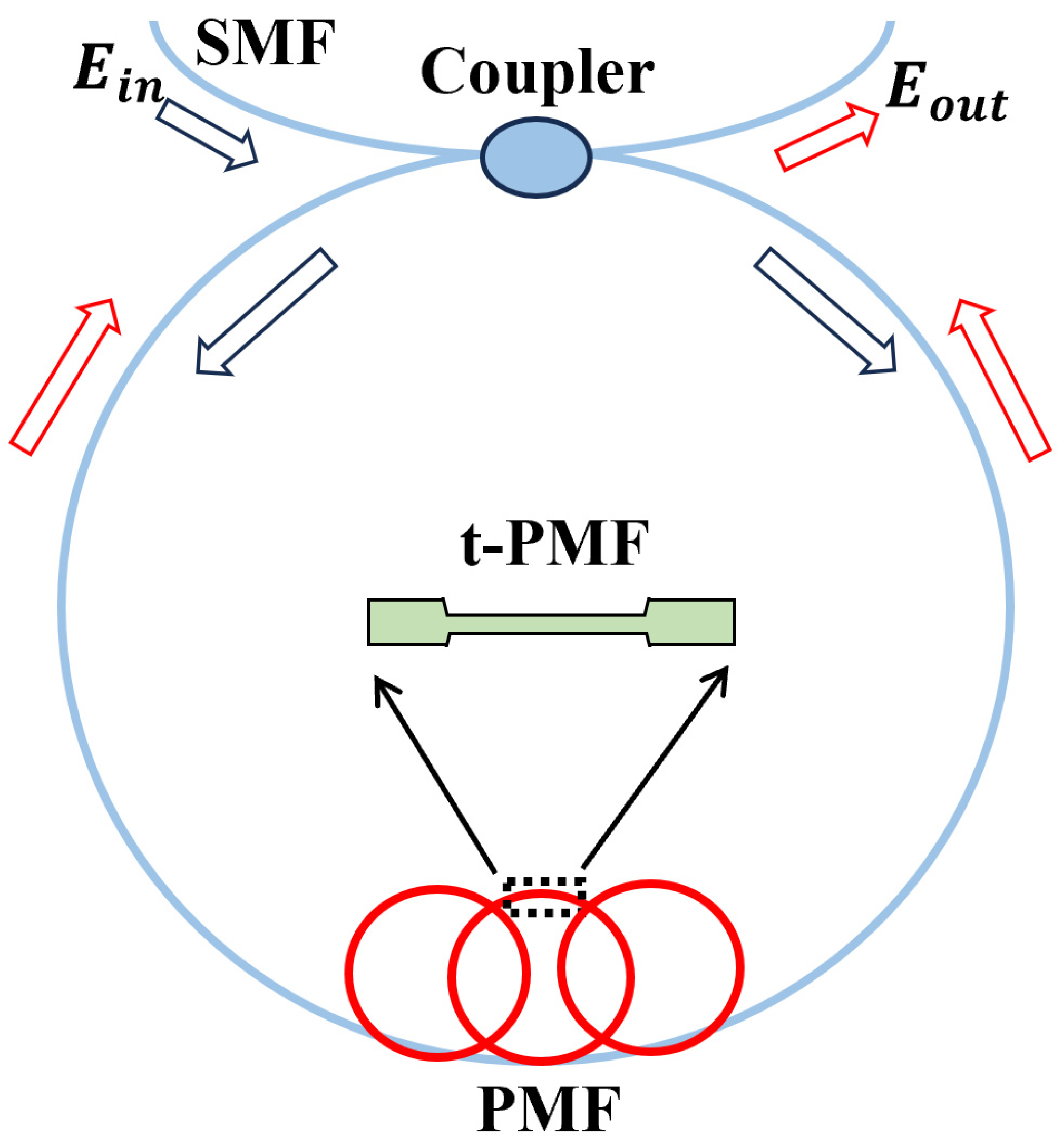
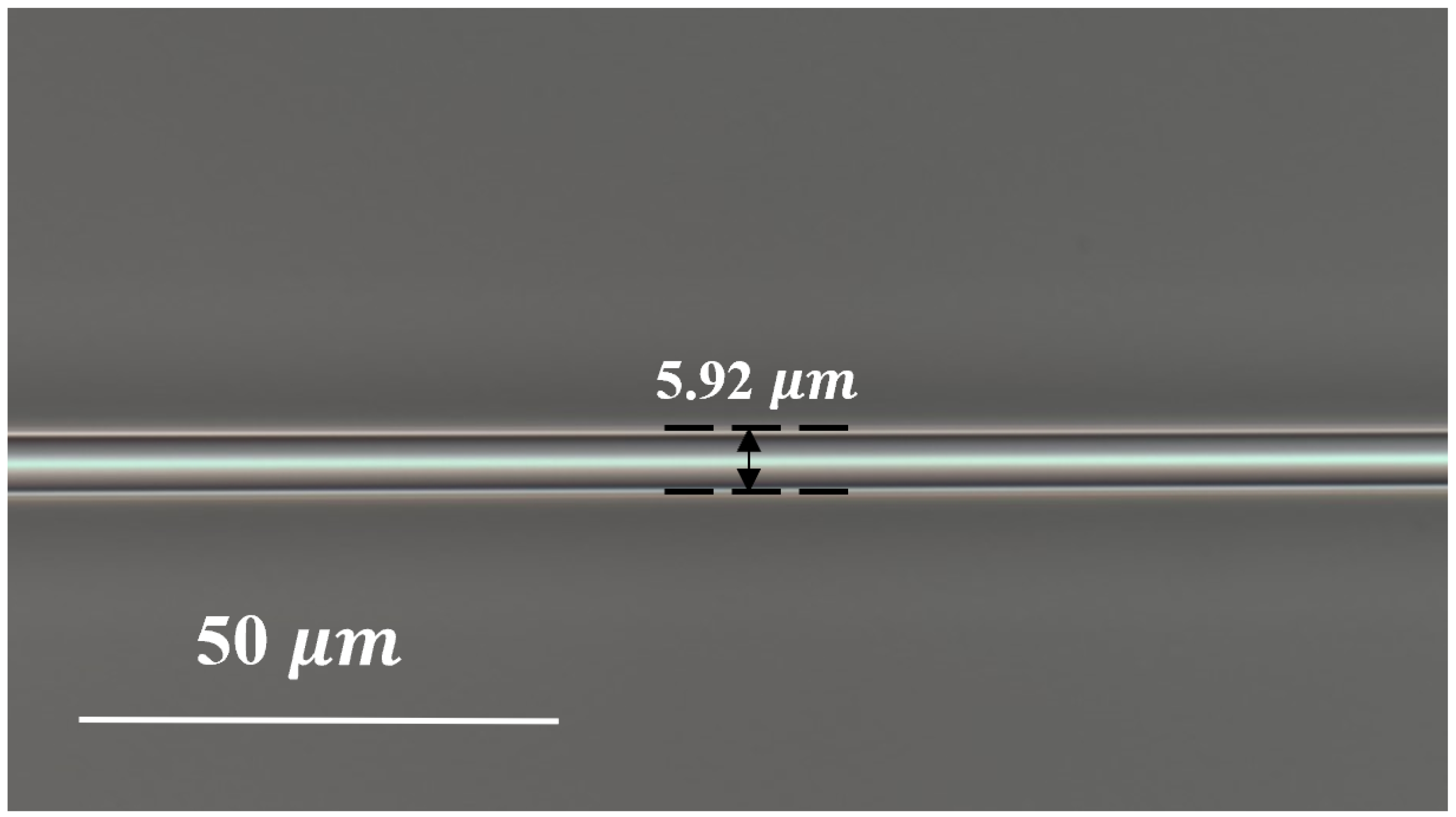

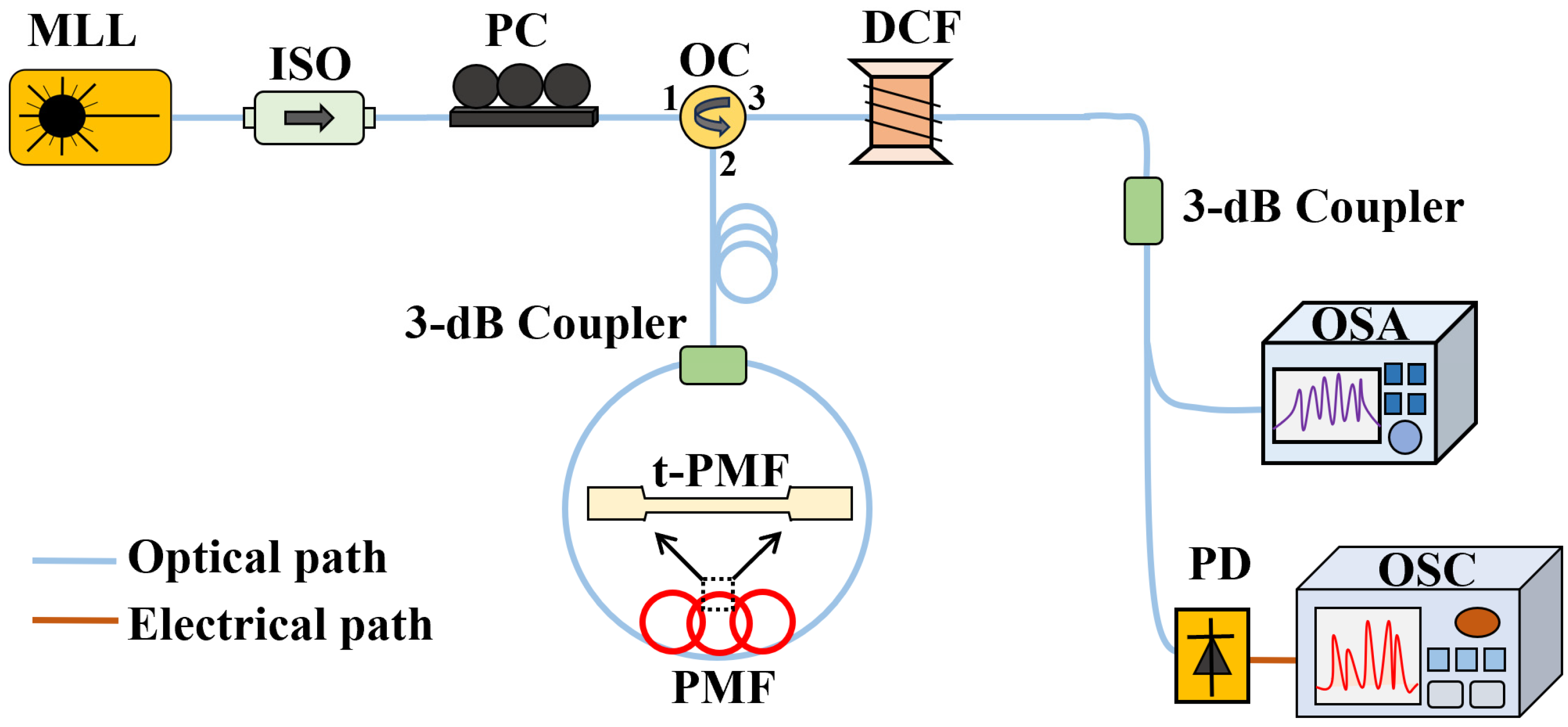
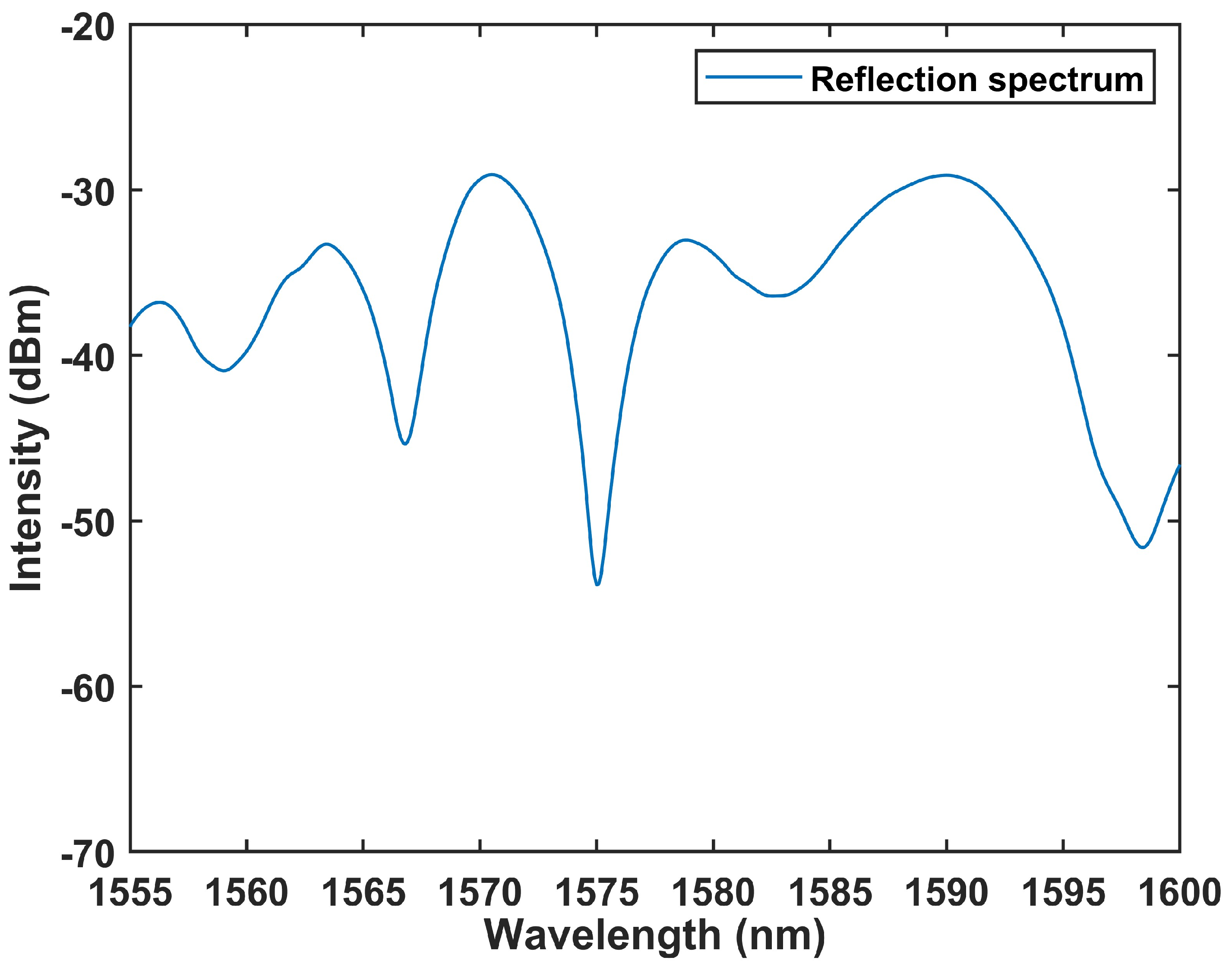
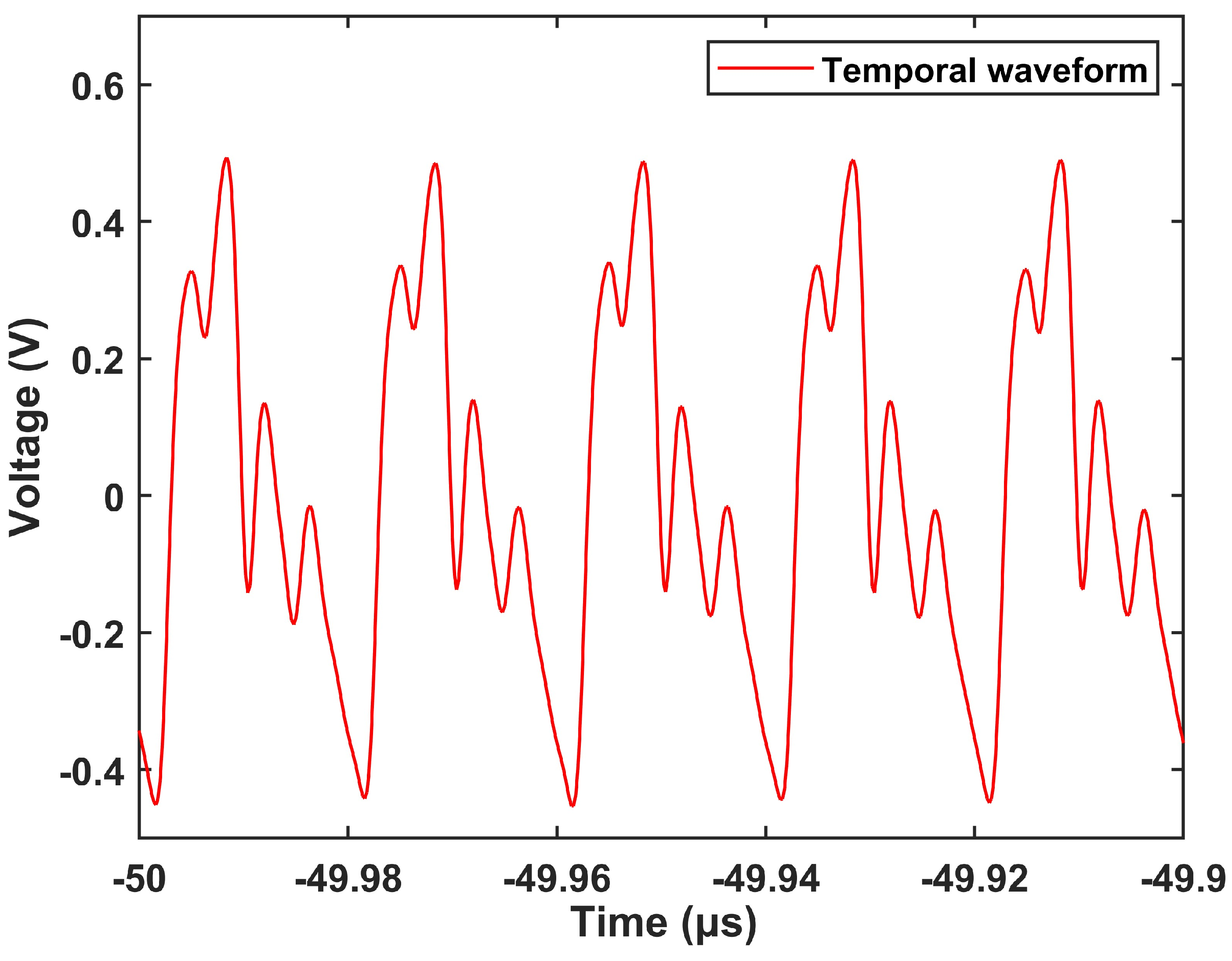
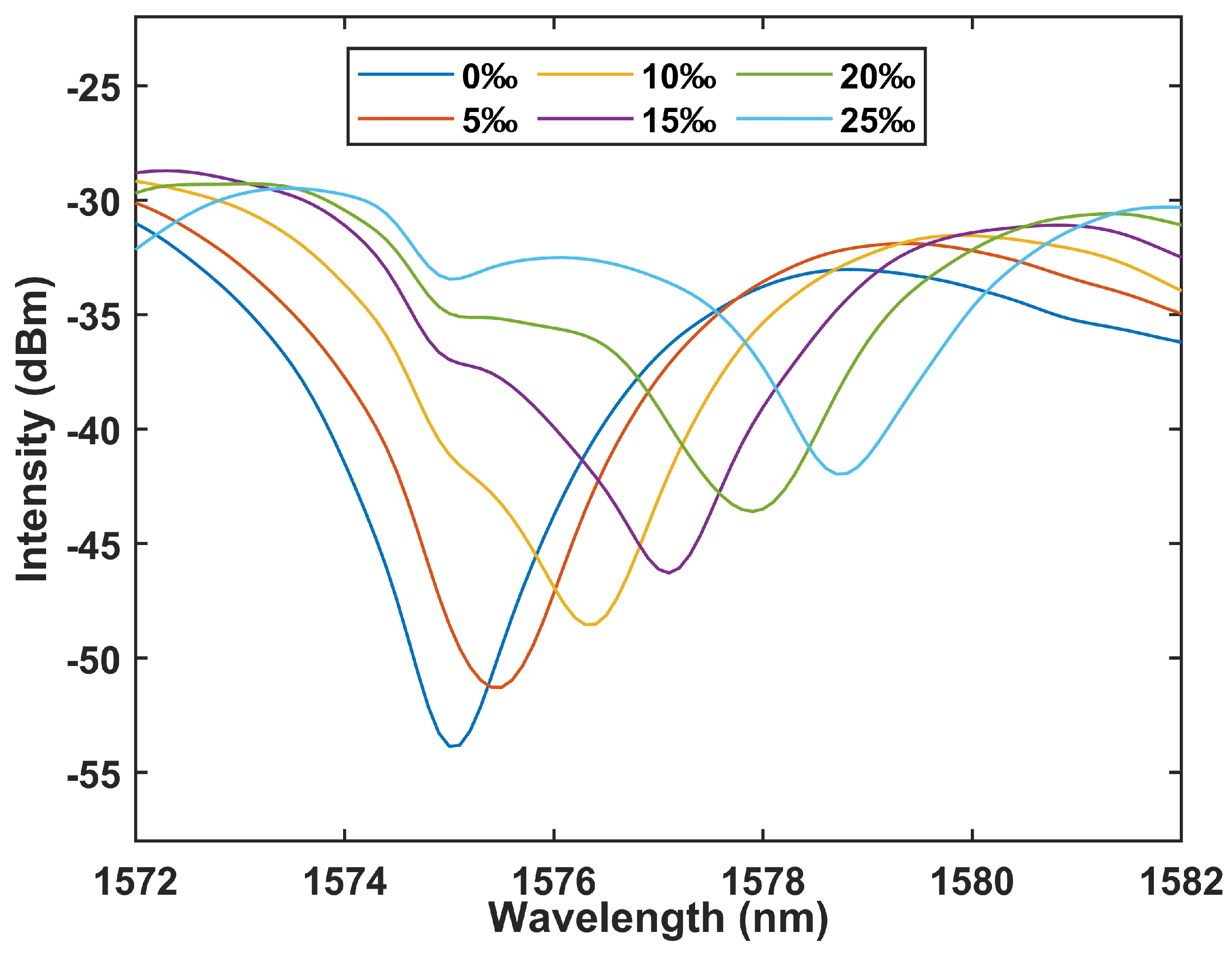
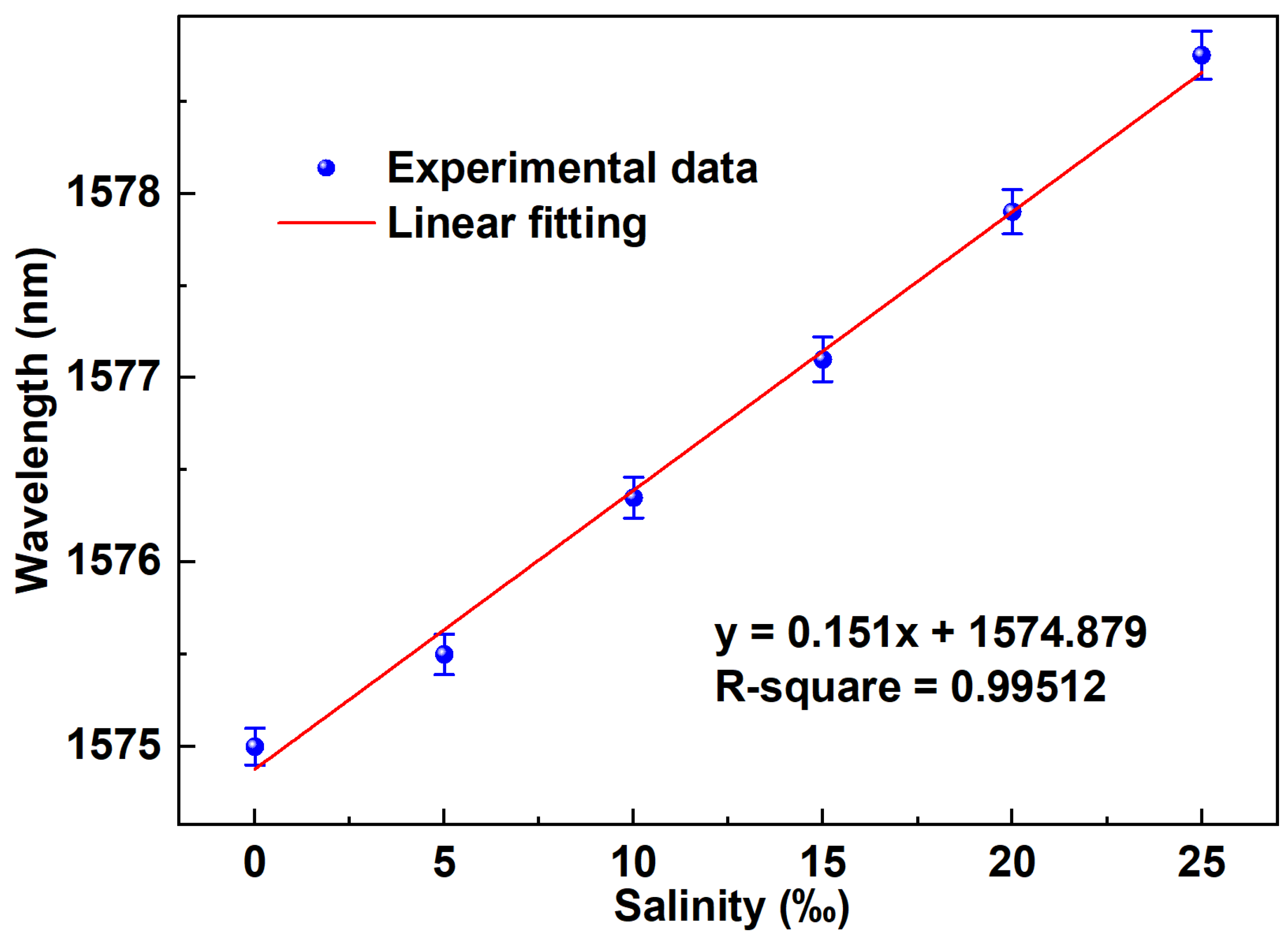



Disclaimer/Publisher’s Note: The statements, opinions and data contained in all publications are solely those of the individual author(s) and contributor(s) and not of MDPI and/or the editor(s). MDPI and/or the editor(s) disclaim responsibility for any injury to people or property resulting from any ideas, methods, instructions or products referred to in the content. |
© 2024 by the authors. Licensee MDPI, Basel, Switzerland. This article is an open access article distributed under the terms and conditions of the Creative Commons Attribution (CC BY) license (https://creativecommons.org/licenses/by/4.0/).
Share and Cite
Lin, W.; Zhao, F.; Hu, J.; Liu, Y.; Xu, R.; Chen, X.; Shao, L. Real-Time Optical Fiber Salinity Interrogator Based on Time-Domain Demodulation and TPMF Incorporated Sagnac Interferometer. Sensors 2024, 24, 5339. https://doi.org/10.3390/s24165339
Lin W, Zhao F, Hu J, Liu Y, Xu R, Chen X, Shao L. Real-Time Optical Fiber Salinity Interrogator Based on Time-Domain Demodulation and TPMF Incorporated Sagnac Interferometer. Sensors. 2024; 24(16):5339. https://doi.org/10.3390/s24165339
Chicago/Turabian StyleLin, Weihao, Fang Zhao, Jie Hu, Yuhui Liu, Renan Xu, Xingwei Chen, and Liyang Shao. 2024. "Real-Time Optical Fiber Salinity Interrogator Based on Time-Domain Demodulation and TPMF Incorporated Sagnac Interferometer" Sensors 24, no. 16: 5339. https://doi.org/10.3390/s24165339







